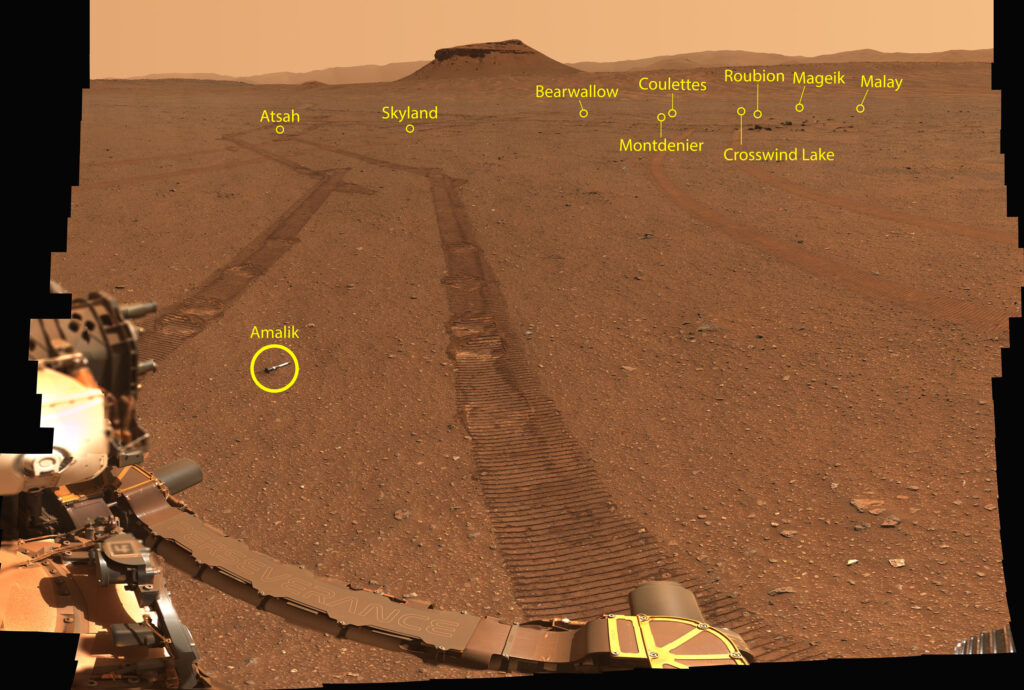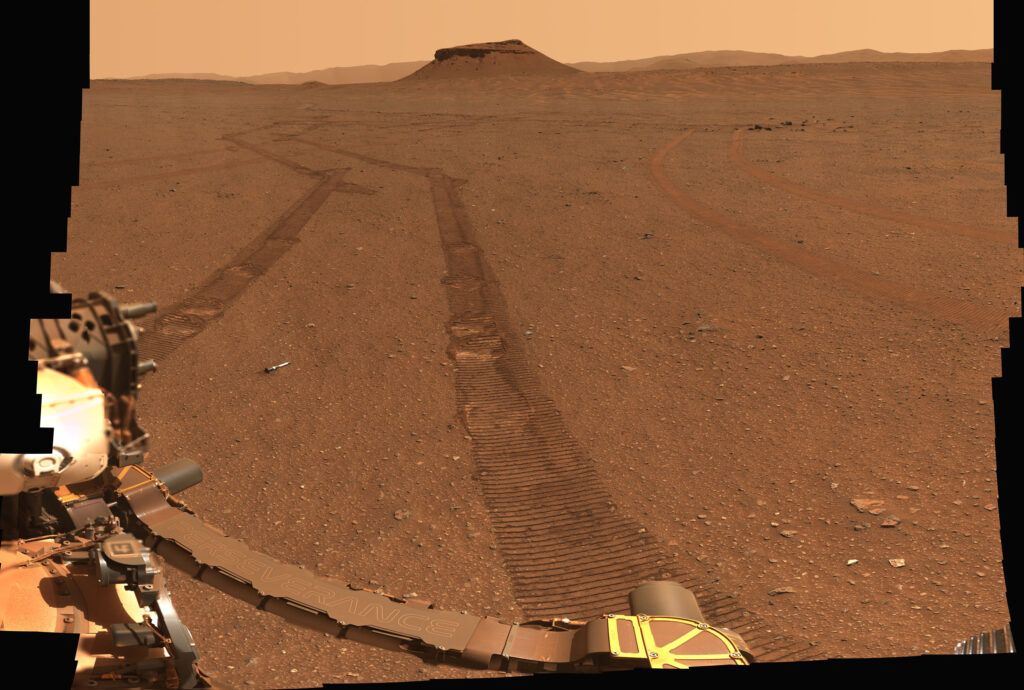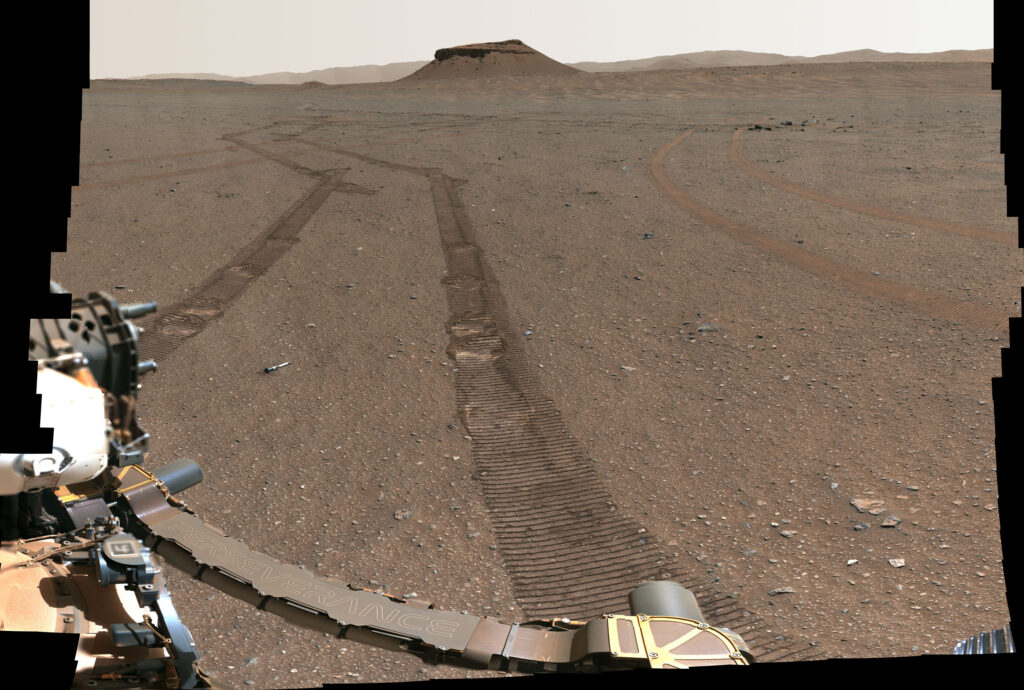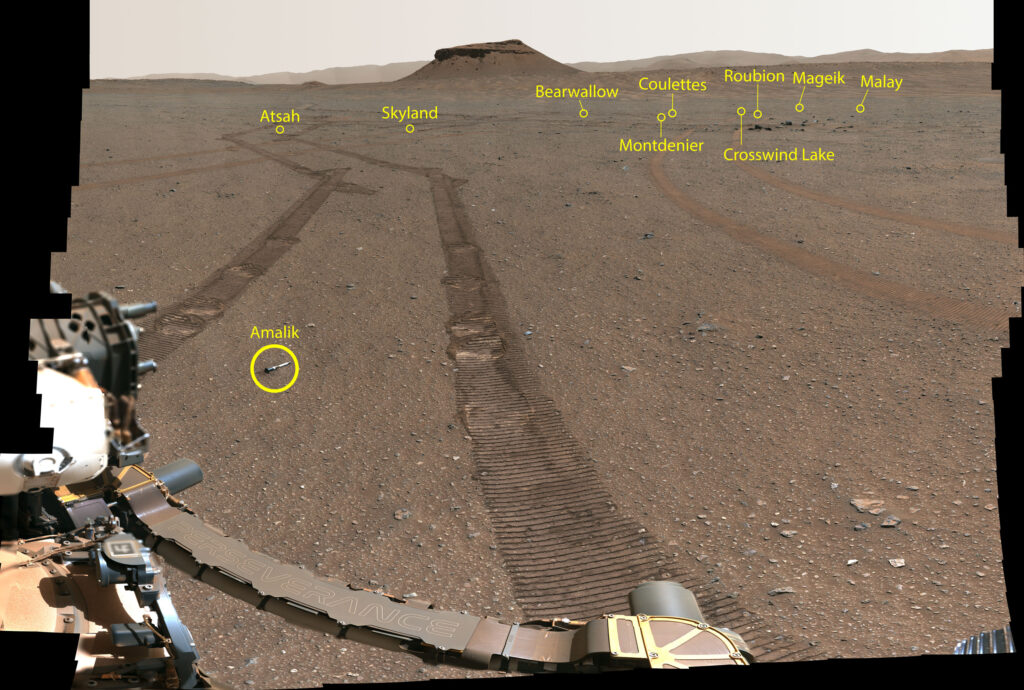
Mastcam-Z Three Forks Sample Depot (sol 693)
Posted by Jim Bell
[Note: The banner image and other views embedded in the text here are low-resolution JPEGs, because the full-resolution versions of these more than 29,000×20,000 pixel mosaics exceed the allowable size of JPEG files! For full-resolution versions of this Mastcam-Z mosaic in PNG or TIFF formats, in natural and enhanced color, with and without annotations, and including 3-D anaglyphs for red/blue glasses, click on the links at the bottom of this posting…]
This text is based on the NASA/JPL Photojournal media release for this mosaic, online at https://photojournal.jpl.nasa.gov/catalog/PIA25736.
NASA’s Perseverance Mars rover captured this portrait of its recently completed sample depot using its Mastcam-Z camera on Jan. 31, 2023, the 693rd Martian day, or sol, of the mission. This panorama is made up of 368 individual images that were stitched together after being sent back to Earth. The color in the natural color scene (Figure 1) has been adjusted to show the Martian surface as it would look to the human eye.

Figure A is the same natural-color version annotated with the names of each of the samples in the depot.

The “Amalik” sample closest to the rover was approximately 10 feet (3 meters) away from the camera at the time the image was taken. The “Atsah” and “Skyland” samples were approximately 66 feet (20 meters) away. “Bearwallow,” “Coulettes,” “Montdenier,” “Crosswind Lake,” and “Roubion” were approximately 115 to 164 feet (35 to 50 meters) away. “Mageik” and “Malay” were approximately 197 feet (60 meters) away.
Each sample tube is approximately 7 inches (18 centimeters) long and 0.8 inches (2 centimeters) in diameter.
Figure B is an enhanced-color version of the scene; the color bands of the image have been processed to improve visual contrast and accentuate color differences.

Figure C is the same enhanced-color version annotated with the names of each of the samples in the depot.

Throughout its science campaigns, the rover has been taking a pair of samples from rocks the mission team deems scientifically significant. One sample from each pair taken so far now sits in the depot – along with one atmospheric sample and one “witness” tube – for a total of 10 tubes that were carefully arranged on the surface in a zigzag pattern.
The depot is a crucial milestone in the NASA-ESA (European Space Agency) Mars Sample Return campaign, which aims to bring Mars samples to Earth for closer study. The Perseverance rover will be the primary means to hand off the collected samples to a future robotic lander as part of the campaign. The lander would, in turn, use a robotic arm to place the samples in a containment capsule aboard a small rocket that would blast off to Mars orbit, where another spacecraft would capture the sample container and return it safely to Earth. Hosting a duplicate set, the depot will serve as a backup if Perseverance can’t deliver its samples.
Perseverance built the depot at “Three Forks,” a location within Mars’ Jezero Crater. Billions of years ago, this crater was filled by a lake and delta. Sediment that built up in the delta formed a steep mound that Perseverance will be driving up in the months ahead to arrive at the top of the delta.
Arizona State University leads the operations of the Mastcam-Z instrument, working in collaboration with Malin Space Science Systems in San Diego, on the design, fabrication, testing, and operation of the cameras, and in collaboration with the Neils Bohr Institute of the University of Copenhagen on the design, fabrication, and testing of the calibration targets.
A key objective for Perseverance’s mission on Mars is astrobiology, including the search for signs of ancient microbial life. The rover will characterize the planet’s geology and past climate, pave the way for human exploration of the Red Planet, and be the first mission to collect and cache Martian rock and regolith (broken rock and dust).
Subsequent NASA missions, in cooperation with ESA (European Space Agency), would send spacecraft to Mars to collect these sealed samples from the surface and return them to Earth for in-depth analysis.
The Mars 2020 Perseverance mission is part of NASA’s Moon to Mars exploration approach, which includes Artemis missions to the Moon that will help prepare for human exploration of the Red Planet.
NASA’s Jet Propulsion Laboratory, which is managed for NASA by Caltech in Pasadena, California, built and manages operations of the Perseverance rover. Arizona State University leads the operations of the Mastcam-Z instrument, working in collaboration with Malin Space Science Systems in San Diego, on the design, fabrication, testing, and operation of the cameras, and in collaboration with the Neils Bohr Institute of the University of Copenhagen on the design, fabrication, and testing of the calibration targets.
For more about Perseverance: mars.nasa.gov/mars2020/
For more about the Mars Sample Return campaign: mars.nasa.gov/msr
LINKS TO (GIANT!) FULL RESOLUTION VERSIONS, INCLUDING 3-D STEREO VERSIONS
Without Annotations:
1) Full-resolution Left Eye, Natural Color: PNG format (29705×20033 pixels; 881 MBytes)
2) Full-resolution Left Eye, Natural Color: TIFF format (29705×20033 pixels; 1.03 GBytes)
3) Full-resolution Left Eye, Enhanced Color: PNG format (29705×20033 pixels; 940 MBytes)
4) Full-resolution Left Eye, Enhanced Color: TIFF format (29705×20033 pixels; 1.11 GBytes)
5) Full-resolution Left+Right Eye Colorglyph, Natural Color: PNG format (28497×19435; 798 MBytes)
6) Full-resolution Left+Right Eye Colorglyph, Natural Color: TIFF format (28497×19435; 986 MBytes)
7) Full-resolution Left+Right Eye Colorglyph, Enhanced Color: PNG format (28497×19435; 871 MBytes)
8) Full-resolution Left+Right Eye Colorglyph, Enhanced Color: TIFF format (28497×19435; 1.13 GBytes)
9) Full-resolution Left+Right Eye Anaglyph, Red Filter only: PNG format (28497×19435; 787 MBytes)
10) Full-resolution Left+Right Eye Anaglyph, Red Filter only: TIFF format (28497×19435; 902 MBytes)
11) Full-resolution Left+Right Eye Anaglyph, Blue Filter only: PNG format (28497×19435; 902 MBytes)
With Annotations:
13) Full-resolution Left Eye, Natural Color, Annotated: PNG format (29705×20033 pixels; 878 MBytes)
14) Full-resolution Left Eye, Enhanced Color, Annotated: PNG format (29705×20033 pixels; 976 MBytes)
January 31, 2023